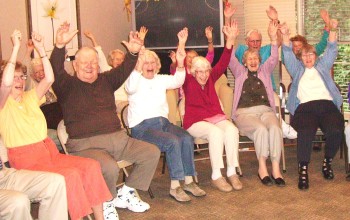Boost Your Energy and Immunity with Laughter Yoga
[caption id="attachment_2372" align="aligncenter" width="350"] Laughing at Ida Culver[/caption] You may have noticed, on our calendar, that Ballard Senior Center features a free class in Laughter Yoga (LY) every Thursday. Maybe you've encountered Laughter Yoga in one of Seattle's assisted living settings, in a corporate context, on the curriculum at Bastyr University, Bellevue college or the campus of University of Washington. Laughter Yoga is embraced and offered in many venues because it's fun and healing and you don't have to be in a good mood to reap its benefits! Find relaxation, improve your blood pressure, boost your immune system, and reduce stress while you laugh. LY exercises are suitable for all ages and require no equipment... just you, your stamina, and your willingness to try it. [caption id="attachment_2439" align="alignright" width="314"]
Laughing at Ida Culver[/caption] You may have noticed, on our calendar, that Ballard Senior Center features a free class in Laughter Yoga (LY) every Thursday. Maybe you've encountered Laughter Yoga in one of Seattle's assisted living settings, in a corporate context, on the curriculum at Bastyr University, Bellevue college or the campus of University of Washington. Laughter Yoga is embraced and offered in many venues because it's fun and healing and you don't have to be in a good mood to reap its benefits! Find relaxation, improve your blood pressure, boost your immune system, and reduce stress while you laugh. LY exercises are suitable for all ages and require no equipment... just you, your stamina, and your willingness to try it. [caption id="attachment_2439" align="alignright" width="314"] Verde and class at TheHub[/caption] Laughter Yoga is fun and playful yet, as Teresa Verde, a pioneer, of Laughter Yoga in Seattle and Certified Laughter teacher since 2001, explains, "This is a vigorous exercise. It is basically a "laughter workout." Is Laughter Yoga good for elders? I asked. Yes. Laughter increases energy by oxygenating the system and triggering the "happiness factor." Keys to a positive experience? Being open to new things, having some level of stamina, and participating in a group that embraces the idea. Caregivers? Laughter Yoga is also good for you. It relieves stress, can be practiced in the moment, and promotes wellness.
Verde and class at TheHub[/caption] Laughter Yoga is fun and playful yet, as Teresa Verde, a pioneer, of Laughter Yoga in Seattle and Certified Laughter teacher since 2001, explains, "This is a vigorous exercise. It is basically a "laughter workout." Is Laughter Yoga good for elders? I asked. Yes. Laughter increases energy by oxygenating the system and triggering the "happiness factor." Keys to a positive experience? Being open to new things, having some level of stamina, and participating in a group that embraces the idea. Caregivers? Laughter Yoga is also good for you. It relieves stress, can be practiced in the moment, and promotes wellness. 11 August, 2015


 Northaven Senior Living, located in the Northgate neighborhood across from the Post Office, is a friendly place. The all glass entrance to Northaven Independent Living opens into a modest and comfortable common space. Northaven Assisted Living is tucked safely behind the main building. It too opens into a comfortable common space where I found two ladies dozing and one anxious to engage me as I waited to talk with Assisted Living Director, Mary Quarterman, and Foundation Director, Bill Dorn. I enjoyed sitting in the safe, unpretentious and welcoming atmosphere. I never imagined it was on the front lines of Seattle's "quiet crisis."
Northaven Senior Living, located in the Northgate neighborhood across from the Post Office, is a friendly place. The all glass entrance to Northaven Independent Living opens into a modest and comfortable common space. Northaven Assisted Living is tucked safely behind the main building. It too opens into a comfortable common space where I found two ladies dozing and one anxious to engage me as I waited to talk with Assisted Living Director, Mary Quarterman, and Foundation Director, Bill Dorn. I enjoyed sitting in the safe, unpretentious and welcoming atmosphere. I never imagined it was on the front lines of Seattle's "quiet crisis."
